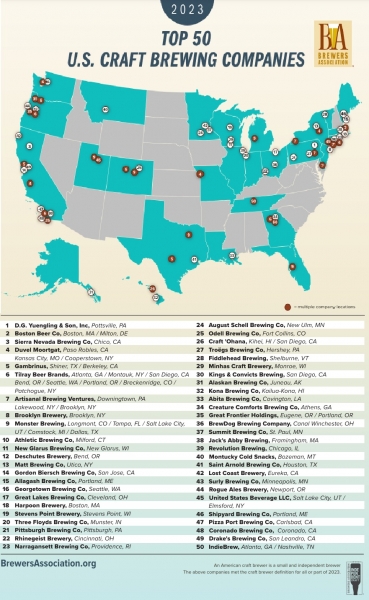US craft beer: The latest market statistics

The Association – which represents small and independent American craft brewers – has this week published annual production figures for the US craft brewing in 2023.
Collectively, small and independent brewers produced 23.4 million barrels of beer in 2023, a decline of 1% from 2022. However, craft’s share of the overall beer market grew to 13.3%, up from 13.1% in 2022 (by volume). That’s because craft’s declines (1%) were smaller than overall beer volume losses (at 5.1%).
Another strong point for the industry was that the number of craft breweries continued to climb in 2023, reaching an all-time high of 9,683. That includes 2,071 microbreweries, 3,467 brewpubs, 3,900 taproom breweries, and 245 regional craft breweries.
The total US operating brewery count was 9,812, up from 9,730 in 2022. Throughout the year, there were 495 new brewery openings and 418 closings.
Openings decreased for a second consecutive year, with the trend reflecting a more mature market. The closing rate increased in 2023 but continued to remain relatively low, at approximately 4%.
Craft beer trajectory
Craft beer enjoyed strong growth throughout the 1990s and 2000s (at times enjoying double-digit growth rates) but by 2019 was already turning into a more mature market with healthy but steadier growth rates (4% volume growth in 2019, against a backdrop of industry declines of 2%).
The pandemic, however, hit the sector hard: being small businesses by definition, craft brewers were among the most vulnerable companies, while many rely on taprooms and the on-trade, which had to close during the peak of the pandemic. As a result, craft beer production dropped 9% in 2020.
But although the pandemic hit hard, the industry largely recovered the following year. But that was only to find a new set of hurdles across 2021 and 2022: such as rising operating and material costs, supply chain challenges, and increased competition.
Craft brewers also have to question whether inflation-hit consumers are going to down-trade from premium craft products to mainstream ones (although the premium category hasn’t taken the hit that might be expected, according to US data).
Craft brewers directly employed 191,421 people in 2023, a 1.1% increase from 2022. That's been driven by the growing number of breweries and a continued shift to hospitality-focused business models.
“2023 was another competitive and challenging year for small and independent brewers,” said Bart Watson, vice president of strategy and chief economist of the Brewers Association.
“Nevertheless, even as growth has downshifted, small brewers have proved quite resilient, as seen in the increase in number of breweries, relatively low closing rates, and gains in onsite sales and jobs.”
Sales across the beer market as a whole have grown stronger in value terms than volume terms: primarily due to pricing but also due to slightly stronger onsite sales growth versus distribution.
“As always, the beverage alcohol market and consumer demand continue to evolve,” added Watson. ”Many brewers are accordingly updating their operations to match those changes, focusing on their business models, go-to-market strategies, and brand strategies to help their businesses match those shifts.”
The top 50 US brewers
The Brewers Association has also released its annual list of the top 50 producing craft brewing companies and overall brewing companies in the US, based on beer sales volume.
Of the top 50 overall brewing companies in 2023, 40 were small and independent craft brewing companies.
“While distribution is as competitive as ever, we continue to see success stories and pockets of growth across the top 50 list,” said Watson. “Even in an era of slow growth, the strongest brands still resonate with beer drinkers, regardless of company size or location.”




